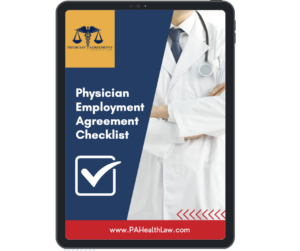Physician agreement horror stories abound. Last year around Halloween I recounted some of the gruesome physician contract horror stories I have witnessed.
As Halloween approaches again, it is probably time for a hair-raising sequel.
Physician Agreement Horror Stories Chapter 1 - "The physician has already agreed to that."
The purpose of a letter of intent is to assure that the employer and the physician are “on the same page.” If the employer wants to pay a given salary for five days of patient contact hours per week, and the physician expects a significantly higher salary for four days of patient contact, there isn’t a high likelihood that this arrangement is going to work.
Letters of intent for physicians are designed to avoid major misunderstandings in developing a physician employment agreement. However, just because the parties have agreed on some major deal points (e.g., salary, patient contact hour requirements, etc.) doesn’t mean that all the details are agreed upon. Accordingly, most letters of intent provide that they are not legally binding.
The “not legally binding” provision has created huge issues for many physicians. I have represented too many physicians who see that a piece of paper isn’t legally binding, so they sign it although they don’t like all its terms (or don’t have access to MGMA benchmarks to know if the terms are reasonable). Since the letter of intent isn’t legally binding, they reason, there is no need to sweat the details now.
The employer, however, usually sees things differently. I have been involved in many situations where the physician employment agreement negotiation has gone sideways when I point out that a signing bonus, salary, or other physician benefits are less than MGMA median benchmarks. Many times I have been shut down when the employer’s counsel flatly declares that “the physician has already agreed to that.” This “agreement”, of course, was assumed because the letter of intent contained that provision.
It is critically important that physicians realize that the “nonbinding” letter of intent is not a meaningless document. Don’t sign anything if you either disagree with something in it, or are unsure if a term is fair. Don’t be faced with “the physician already agreed to that” unless you are actually OK with a given term. If you intend to bring in a physician’s attorney to review an agreement, always get them involved before you sign a letter of intent.
Physician Agreement Horror Stories Chapter 2 - "You will make up for it when you become partner."
Let me start off by saying that the vast majority of private practice physicians are honorable and want to make new physicians their partners after they have proven themselves. But, in the 40 years or so that I have been involved in physician employment agreements with a private practice I have run into a few practices with a different business model, and physicians who work there have their own physician agreement horror stories to tell.
These practices appear to intentionally hire physicians out of training with promises of riches (or at least a decent income) once they make partners. An MGMA compensation analysis frequently reveals that the physician signing bonus and relocation allowance are well below median for starting physician at private practices in that area. Often the salary is also well below median.
The practice explains that the low salary is a way to buy into the practice cheaply (i.e., you don’t pay taxes on money you don’t earn, and the practice claims it will “credit” the money it didn’t pay you to your buy-in). The problem is, after a few years when it is time for partnership, the practice either decides it won’t make the physician a partner, or it terminates the physician without cause.
Unfortunately, there aren’t a lot of ways to contractually protect yourself from a dishonest practice. Without cause termination in physician employment contracts is common, and desirable from both the physician and the employer perspective. One of the best ways to protect yourself is to obtain a reasonable salary, sign-on bonus and relocation allowance up front. You should also ask any departing physicians why they are leaving. If possible, try to see who else has worked at that practice, and speak to them as well.
Physician Agreement Horror Stories Chapter 3
"It's a full-time position."
Another of the more gruesome physician agreement horror stories involves physician employment agreements that are silent as to patient contact hour requirements. Many first drafts provide that the physician will work 40 hours per week, or will be a 1.0 FTE (full time equivalent). That seems reasonable at first blush. A 40 hour work week is standard in this country. Coming out of training, 40 hours per week may seem almost like a vacation.
Unfortunately, many physicians accept this provision and then are scheduled for 40 patient contact hours per week. The problem, of course, is that physicians have a host of duties beyond hands-on treatment of patients. A week with 40 patient contact hours can easily become a 60 hour week (ignoring call coverage requirements).
I was once in a negotiation where the employer insisted that 36 patient contact hours per week was a part time position. Needless to say, extensive negotiations were required to try to obtain a reasonable situation for the physician.
To prevent this horror story, you should ensure that patient contact hour requirements are clearly provided in the agreement. When I do a physician contract review I always attempt to obtain 32 patient contact hours per week. I’m seeing more and more employers who are willing to accept 36 patient contact hours per week, which means you won’t have to bring charting home at least one night per week!
If you would like to avoid living in a physician agreement horror story, you can start your review here. We also offer a free consultation to see how we can help. You might also be interested in my book on physician employment agreements.



